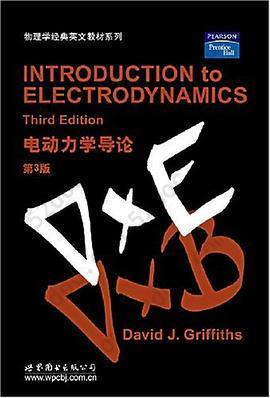注重体验与质量的电子书资源下载网站
分类于: 职场办公 其它
简介

电动力学导论: 电动力学导论 豆 9.2分
资源最后更新于 2020-08-20 14:03:47
作者:David J.Griffiths
出版社:世界图书出版公司
出版日期:2006-01
ISBN:9787506272896
文件格式: pdf
标签: 电动力学 物理 英文原版 物理学 教材 经典电动力学 ElecttroDynamics 经典
简介· · · · · ·
《电动力学导论》(第3版)主要介绍了大学本科物理系的一门支柱课程电动力学。它和理论力学、热力学和统计物理学以及量子力学一起通常称为“四大力学”,构成对学生进行基础物理学理论知识训练的核心,也是进一步学习更高等的基础课和各类专业课必不可少的准备知识。在自然界已知的4种相互作用力(引力、电磁力、强相互作用力和弱相互作用力)中,电磁力是我们了解得最清楚的。它在我们日常的生活与生产活动以及各类技术的进步中起着无可置疑的支配作用。而电动力学正是介绍电磁规律的理论课程。因此,它不仅是物理系本科生的必修课,也是范围越来越广的理工科学生选修的课程。从事电动力学教和学的师生,多年来一直有一个困惑,或者有一。
目录
preface.
advertisement
1 vector analysis
1.1 vector algebra
1.2 differential calculus
1.3 integral calculus
1.4 curvilinear coordinates
1.5 the dirac delta function
1.6 the theory of vector fields
2 electrostatics
2.1 the electric field
2.2 divergence and curl of electrostatic fields
2.3 electric potential
2.4 work and energy in electrostatics
2.5 conductors
3 special techniques
3.1 laplace's equation
3.2 the method of images
3.3 separation of variables
3.4 multipole expansion
.4 electric fields in matter
4.1 polarization
4.2 the field of a polarized object
4.3 the electric displacement
4.4 linear dielectrics
5 magnetostatics
5.1 the lorentz force law
5.2 the biot-savart law..
5.3 the divergence and curl of b
5.4 magnetic vector potential
6 magnetic fields in matter
6.1 magnetization
6.2 the field of a magnetized object
6.3 the auxiliary field h
6.4 linear and nonlinear media
7 electrodynamics
7.1 electromotive force
7.2 electromagnetic induction
7.3 maxwell's equations
8 conservation laws
8.1 charge and energy
8.2 momentum
9 electromagnetic waves
9.1 waves in one dimension
9.2 electromagnetic waves in vacuum
9.3 electromagnetic waves in matter
9.4 absorption and dispersion
9.5 guided waves
10 potentials and fields
10.1 the potential formulation
10.2 continuous distributions
10.3 point charges
11 radiation
11.1 dipole radiation
11.2 point charges
12 eiectrodynamics and relativity
12.1 the special theory of relativity
12.2 relativistic mechanics
12.3 relativistic electrodynamics
a vector calculus in curvilinear coordinates
a.1 introduction
a.2 notation
a.3 gradient
a.4 divergence
a.5 curl
a.6 laplacian
b the helmholtz theorem
c units
inde
advertisement
1 vector analysis
1.1 vector algebra
1.2 differential calculus
1.3 integral calculus
1.4 curvilinear coordinates
1.5 the dirac delta function
1.6 the theory of vector fields
2 electrostatics
2.1 the electric field
2.2 divergence and curl of electrostatic fields
2.3 electric potential
2.4 work and energy in electrostatics
2.5 conductors
3 special techniques
3.1 laplace's equation
3.2 the method of images
3.3 separation of variables
3.4 multipole expansion
.4 electric fields in matter
4.1 polarization
4.2 the field of a polarized object
4.3 the electric displacement
4.4 linear dielectrics
5 magnetostatics
5.1 the lorentz force law
5.2 the biot-savart law..
5.3 the divergence and curl of b
5.4 magnetic vector potential
6 magnetic fields in matter
6.1 magnetization
6.2 the field of a magnetized object
6.3 the auxiliary field h
6.4 linear and nonlinear media
7 electrodynamics
7.1 electromotive force
7.2 electromagnetic induction
7.3 maxwell's equations
8 conservation laws
8.1 charge and energy
8.2 momentum
9 electromagnetic waves
9.1 waves in one dimension
9.2 electromagnetic waves in vacuum
9.3 electromagnetic waves in matter
9.4 absorption and dispersion
9.5 guided waves
10 potentials and fields
10.1 the potential formulation
10.2 continuous distributions
10.3 point charges
11 radiation
11.1 dipole radiation
11.2 point charges
12 eiectrodynamics and relativity
12.1 the special theory of relativity
12.2 relativistic mechanics
12.3 relativistic electrodynamics
a vector calculus in curvilinear coordinates
a.1 introduction
a.2 notation
a.3 gradient
a.4 divergence
a.5 curl
a.6 laplacian
b the helmholtz theorem
c units
inde








